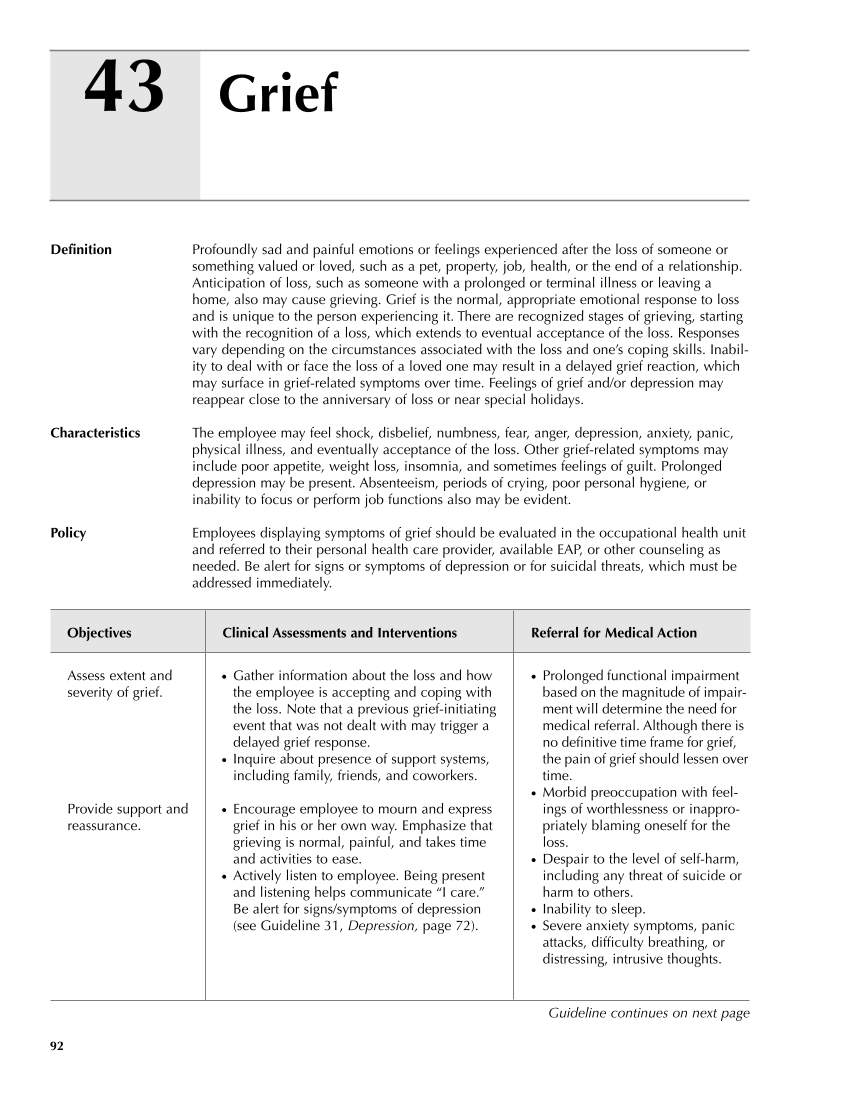43 92 Definition Profoundly sad and painful emotions or feelings experienced after the loss of someone or something valued or loved, such as a pet, property, job, health, or the end of a relationship. Anticipation of loss, such as someone with a prolonged or terminal illness or leaving a home, also may cause grieving. Grief is the normal, appropriate emotional response to loss and is unique to the person experiencing it. There are recognized stages of grieving, starting with the recognition of a loss, which extends to eventual acceptance of the loss. Responses vary depending on the circumstances associated with the loss and one’s coping skills. Inabil- ity to deal with or face the loss of a loved one may result in a delayed grief reaction, which may surface in grief-related symptoms over time. Feelings of grief and/or depression may reappear close to the anniversary of loss or near special holidays. Characteristics The employee may feel shock, disbelief, numbness, fear, anger, depression, anxiety, panic, physical illness, and eventually acceptance of the loss. Other grief-related symptoms may include poor appetite, weight loss, insomnia, and sometimes feelings of guilt. Prolonged depression may be present. Absenteeism, periods of crying, poor personal hygiene, or inability to focus or perform job functions also may be evident. Policy Employees displaying symptoms of grief should be evaluated in the occupational health unit and referred to their personal health care provider, available EAP, or other counseling as needed. Be alert for signs or symptoms of depression or for suicidal threats, which must be addressed immediately. Objectives Clinical Assessments and Interventions Referral for Medical Action Grief ● Prolonged functional impairment based on the magnitude of impair- ment will determine the need for medical referral. Although there is no definitive time frame for grief, the pain of grief should lessen over time. ● Morbid preoccupation with feel- ings of worthlessness or inappro- priately blaming oneself for the loss. ● Despair to the level of self-harm, including any threat of suicide or harm to others. ● Inability to sleep. ● Severe anxiety symptoms, panic attacks, difficulty breathing, or distressing, intrusive thoughts. Assess extent and severity of grief. Provide support and reassurance. ● Gather information about the loss and how the employee is accepting and coping with the loss. Note that a previous grief-initiating event that was not dealt with may trigger a delayed grief response. ● Inquire about presence of support systems, including family, friends, and coworkers. ● Encourage employee to mourn and express grief in his or her own way. Emphasize that grieving is normal, painful, and takes time and activities to ease. ● Actively listen to employee. Being present and listening helps communicate “I care.” Be alert for signs/symptoms of depression (see Guideline 31, Depression, page 72). Guideline continues on next page
Purchased from OEM Press by (ge corporate access). (C) 2013 OEM Health Information, Inc. All rights reserved.












































































































































































































































































































































































































































